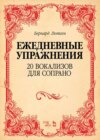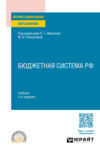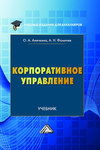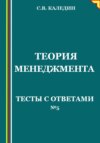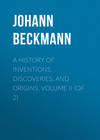Czytaj książkę: «A History of Inventions, Discoveries, and Origins, Volume I (of 2)»
ADVERTISEMENT
In revising Beckmann’s celebrated Work, we have endeavoured to improve it principally by altering such names, characters, descriptions, and opinions as have become obsolete, or are now known to be erroneous; and by such additions as seemed necessary to bring the accounts of the subjects treated of to the present state of knowledge. In some cases, these additions may appear to diverge from the declared object of the work; but in this we have only followed the example of Beckmann himself, who frequently deviates from a strict historical path, and we think advantageously, for the purpose of introducing curious, instructive, or amusing information. In most cases, where the subject under consideration is a process of manufacture, we have given a brief outline of its practice or theory, unless this had previously been done by the author. The translation, also, has been carefully compared with the German, but in only a very few cases could we detect errors which rendered the passages contradictory or unintelligible: on the whole, it is extremely well executed; and too much praise cannot be given to Johnston, for the judicious manner in which he has embodied in one article, detached essays on the same subject, which Beckmann published at different periods, as he acquired fresh information. The only instances in which this had been omitted, are the articles on Turf, Cork, and Quarantine, which were still encumbered with addenda; in the present edition, these have been incorporated. All such quotations from Latin and Greek authors, as might be deemed essential to the understanding of the text, have been given in English; those of a mere critical and philological character, it has been thought advisable to leave untranslated. The book may be classed as a compound of learned research and light reading, suitable both to the popular reader and the scholar; and that character has been preserved in the present edition. To the kindness of John Frodsham, Esq., the present proprietor of Arnold’s Chronometer Establishment, we are indebted for much of the interesting information added to the article on ‘Clocks and Watches;’ and we have also to return our thanks to the publisher, Mr. H. G. Bohn, for the assistance he has constantly afforded us, as well as for his Memoir of the author.
W. Francis.J. W. Griffith.
TRANSLATOR’S PREFACE
That the arts had their rise in the East, and that they were conveyed thence to the Greeks, and from them to the Romans, is universally admitted. Respecting the inventions and discoveries however of the earliest ages, nothing certain is known. Many of those most useful in common life must have been the production of periods when men were little acquainted with letters, or any sure mode of transmitting an account of their improvements to succeeding generations. The taste which then prevailed of giving to every thing a divine origin, rendered traditional accounts fabulous; and the exaggeration of poets tended more and more to make such authorities less worthy of credit. A variety of works also, which might have supplied us with information on this subject, have been lost; and the relations of some of those preserved are so corrupted and obscure, that the best commentators have not been able to illustrate them. This in particular is the case with many passages in Pliny, an author who appears to have collected with the utmost diligence whatever he thought useful or curious, and whose desire of communicating knowledge seems to have been equal to his thirst for acquiring it.
Of all those nations whose history has been preserved, the most distinguished are certainly the Greeks and the Romans; but, as far as can be judged at this remote period, the former were superior to the latter in point of invention. The Romans indeed seem to have known little, except what they borrowed from the Grecians; and it is evident, by their sending their young men of rank to finish their education in Greece, that they considered that country as the seat of the arts and the sciences, and as a school where genius would be excited by the finest models, while the taste was corrected and formed. From some hints given however by Pliny and other writers, we have reason to conclude that the Romans possessed more knowledge of the arts than the moderns perhaps are willing to allow, and that some inventions, considered as new, may be only old ones revived and again rendered useful.
When Rome, abandoned to luxury and vice, became an easy prey to those hordes of barbarians who overran the empire, her arts shared in the general wreck, and were either entirely lost, or for a time forgotten. The deplorable state of ignorance in which Europe was afterwards plunged during several centuries, retarded their revival; and it was not till a late period, when favoured and protected by a few men of superior genius, that they began to be again cultivated. It cannot however be denied, that several important discoveries, altogether unknown to the ancients, which must have had considerable influence on the general state of society, were made in ages that can hardly be exempted from the appellation of barbarous. As a proof of this may be mentioned the invention of paper1, painting in oil2, the mariner’s compass3, gunpowder4, printing5, and engraving on copper6. After the invention of the compass and printing, two grand sources were opened for the improvement of science. In proportion as navigation was extended, new objects were discovered to awaken the curiosity and excite the attention of the learned; and the ready means of diffusing knowledge, afforded by the press, enabled the ingenious to make them publicly known. Ignorance and superstition, the formidable enemies of philosophy in every age, began soon to lose some of that power which they had usurped; and states, forgetting their former blind policy, adopted improvements which their prejudice had before condemned.
Though it might be expected that the great share which new inventions and discoveries have at all times had in effecting such happy changes among mankind would have secured them a distinguished place in the annals of nations, we find with regret, that the pen of history has been more employed in recording the crimes of ambition and the ravage of conquerors, than in preserving the remembrance of those who, by improving science and the arts, contributed to increase the conveniences of life, and to heighten its enjoyments. So little indeed has hitherto been done towards a history of inventions and discoveries, that the rise and progress of part of those even of modern times is involved in considerable darkness and obscurity: of some the names of the inventors are not so much as known, and the honour of others is disputed by different nations; while the evidences on both sides are so imperfect, that it is almost impossible to determine to which the palm is due. To Professor Beckmann, therefore, those fond of such researches are much indebted for the pains he has been at to collect information on this subject; and though he has perhaps not been able to clear up every doubt respecting the objects on which he treats, he has certainly thrown much light on many curious circumstances hitherto buried in oblivion.
The author, with much modesty, gives to this work in the original the title of only Collections towards a History of Inventions: but as he has carefully traced out the rise and progress of all those objects which form the subject of his inquiry, from the earliest periods of their being known, as far as books supplied information, and arranged his matter in chronological order, the original title may admit, without being liable to much criticism, of the small variation adopted in the translation. The author, indeed, has not in these volumes comprehended every invention and discovery, but he has given an account of a great many, most of them very important.
Should any one be disposed to find fault with the author for introducing into his work some articles which on the first view may appear trifling, his own words, taken from the short preface prefixed to the first volume of the original, will perhaps be considered as a better exculpation than anything the translator might advance in his favour. “I am sensible,” says he, “that many here will find circumstances which they may think unworthy of the labour I have bestowed upon them; but those who know how different our judgements are respecting utility, will not make theirs a rule for mine. Those whose self-conceit would never allow them to be sensible of this truth, and who reject as useless all ore in which they do not observe pure gold, as they display very little acuteness, must be often duped by the tinsel glare of false metal; and they give me as little uneasiness as those who have no desire to know the origin of inventions, or how they were brought to their present utility. If my extending the term Invention farther than is perhaps usual, by comprehending under it several police-establishments, be a fault, it is at any rate harmless, and on that account may be pardoned without much apology.”
MEMOIR OF THE AUTHOR
John Beckmann, Professor of Œconomy at Göttingen during a period of forty-five years, was born at Hoye, a small town in the kingdom of Hanover, in 1739. His father held the appointment of postmaster and receiver of taxes in that place, and at the same time cultivated a small farm, which appears to have inspired his son with a taste for agricultural pursuits. The superintendence of his education devolved principally on his mother, a woman of great prudence and strength of mind, who was left a widow when young Beckmann was scarcely seven years old. In a lonely house, amid examples of industry and daily labour, he passed his youth in the perusal of works, which, although of a common-place description, were not without their use, as they led him to contract a methodical habit of mind, and afforded considerable information on various subjects, which in the sequel greatly assisted him in the pursuits to which he owed his celebrity. He himself relates that, when quite a boy, he was in the habit of making extracts of all the striking passages he met with in the course of his reading, by which means he acquired a ready use of the pen. The insufficient circumstances of his family prevented his education being cultivated in the schools till nearly fifteen; at which age he was sent to the Gymnasium of Stade, then under the direction of Gehlen, where in a short time he highly distinguished himself in classical literature. Intended for the clerical profession, he entered the university of Göttingen in 1759, for the purpose of completing his theological studies; but whether the advice of Hollmann (afterwards his father-in-law), with whom he had formed a close intimacy, produced a change in his plans, or that the mathematical instructions of Professors Kaestner and Mayer were more congenial to his mind than divinity, he abandoned the career marked out for him, and devoted himself to the natural sciences and their application, as well as to mathematics; whilst he cultivated philology with such zeal, that he ultimately made himself master of ten different languages. In order to gain greater proficiency in these pursuits, he made a journey in 1762 to the Netherlands, but returned to Hoye in the following year, in consequence of the serious indisposition of his mother, who dying shortly afterwards, left him destitute of guidance, and in the greatest anxiety respecting his future prospects. At this juncture Büsching advised him to travel to St. Petersburg, where, upon the strong recommendations with which he was provided, he was speedily appointed to the chair of Natural Philosophy. Shortly after, Büsching, quitting the institution, returned to Germany, and dissensions having arisen among the directors, Beckmann likewise resigned his office. He then proceeded to Sweden, with the view of acquiring a detailed knowledge of the working of the mines in that country; making his principal sojourn at Upsal, where he became acquainted with Linnæus, and enjoyed the friendship and hospitality, as well as the instructions, of that eminent naturalist7. Leaving Sweden, he directed his course to Denmark, visiting Copenhagen and other towns, where he examined the various museums, libraries and manufacturing establishments. On arriving at Altona, he found there his friend Büsching, who recommended him to Münchhausen, curator of the Academy of Göttingen. After paying a visit to his brother at Marburgh, he proceeded to Hanover; and being approved of by Struve, then president of Göttingen under Münchhausen, he was appointed, in 1766, Professor Extraordinary of Philosophy to that university, of which he eventually became one of the brightest ornaments.
His lectures upon œconomy had the recommendation of novelty, and produced so much applause, that in 1770 he was made ordinary professor of that science. They were attended by the flower of the studious youth of all countries, Göttingen being at that period one of the most popular universities in Europe; and many even of the distinguished statesmen and public functionaries of Germany did not disdain to be ranked among his auditors. He was in the habit of accompanying them himself into the workshops, to give them a practical knowledge of the different processes and handicrafts of which he had explained the theory. Once a week, also, he held a Practicum Camerale, a scientific meeting, at which he explained subjects of œconomy, administration, and finance, illustrating them by readings from a great variety of sources. He composed, to serve as a guide in this course of instruction, treatises on rural œconomy, policy, finance, commerce, and other departments of knowledge; which, though since carried to a higher degree of perfection, owed to Beckmann their first systematic form. He never entirely relinquished these public lectures, but insensibly his private studies took a direction altogether historical, the motives for which it may not be uninteresting to point out.
It is indispensably requisite at Göttingen that every professor should be able to give account of the progress and existing state of the science to which he is appointed. Any one, who two years after the publication of a work of importance in his department should not have read and analysed it, with a view of enriching his own observations, would not be regarded as a worthy successor to the chair of Haller, of Mosheim, of Gessner and Michaelis. Beckmann, who had studied at Göttingen at a time when the example of these great men dictated the law and gave the tone to the University, and perhaps to the literature of Europe, was determined to keep pace with the spirit of the age, and not to remain ignorant of the great advances then making throughout Europe, in the numerous sciences which furnished the subjects of his practical investigations. But this was a task of no slight magnitude: and indeed when the immense additions to so many different sciences are considered, can it be wondered at, that, notwithstanding his utmost zeal and application, he found it impossible to read up all the important works which had appeared since 1770, in chemistry, physics, natural history and mathematics? Despairing of success in so Herculean an undertaking, he began to entertain feelings of aversion towards what he deemed the innovations, which were then changing the face and enlarging the scope of science. But his course of lectures, turning principally on practical matters, was not materially affected; he was, however, so fearful of falling under the imputation of being behind the progress of the age, that he devoted his mind, peculiarly fitted for this kind of study, almost exclusively to the history of arts and trades; employing in the illustration of his subjects, the materials to which he had access in the very extensive library belonging to the university; and it is to his consequent labours and researches that we owe the “History of Inventions and Discoveries.” In this work, Beckmann traces their first germs from the remotest periods of antiquity, and following their gradual development, exhibits the latest improvements among civilized nations with almost unequalled acumen and ability. It abounds with invaluable materials respecting the general history of the origin and progress of the mechanic arts, which are so important a branch in civilization; and what must give it an additional value in the eyes of all who are unwilling to place reliance on assertions unsupported by authority, or may be anxious to investigate the subject more deeply, the most scrupulous references to original authorities accompany each article. Among the numerous other works of merit for which we are indebted to the literary industry of Beckmann, are, “A History and Analysis of early Voyages and Travels,” a highly interesting collection, which occupied the last years of his life, and was left unfinished at the eighth number; elaborate editions of “De Mirabilibus Auscultationibus,” attributed to Aristotle, 1786; “Antigoni Carystii Historiæ Mirabiles,” 1791; and “Marbodi Liber de Gemmis,” 1799; publications which required the rare combination of physical knowledge with philological learning.
The Royal Society of Göttingen had, in the year 1772, admitted him one of its members, and from that period to 1783 he continued to supply their proceedings with interesting memoirs (all written in Latin), among which are the following: “On the Reduction of Fossils to their original substances;” “On the History of Alum;” “On the Sap of Madder;” “On Meerschaum, from which are formed the heads for tobacco pipes;” “On the History of Sugar,” &c. After this period, however, he declined participating any longer in the labours of this learned body; owing, probably, to a change in the objects of his own particular studies. In 1784 he was created an aulic councillor of Hanover; in addition to which he was elected member of the Imperial Academy of Naturalists, of the Swedish Society of Science, of the Academies of Norway and Mayence, of the Physiographical Society of Lund, and of almost all the learned societies in Germany and the North of Europe.
With a copious knowledge of the principal sciences, Beckmann united extensive reading in the works of ancient and modern writers, not only in reference to their immediate connection with his main studies, but in respect also to their application generally to every other branch. Convinced that every professor ought, as much as possible, to have thoroughly searched into all matters relating to the subject on which he treats, he spared no expense in forming a most extensive, as well as choice library; at the same time he did not fail to avail himself of the rich intellectual stores contained in that belonging to the university. His mind being wholly directed to all that is practical in human knowledge, it was his especial endeavour to bring it into systematic rules, based upon fundamental principles. To him particularly is to be ascribed the merit of having been the first to give to agriculture its scientific form, and to have separated it more distinctly than heretofore from the administrative and financial departments. The number of pupils indebted to him for their education, and who, eventually, – whether filling offices of state or following his footsteps as professors, – brought into effect the principles he had taught them, formed a very numerous body; and whilst he was thus the means of considerably enlarging the circle of academic subjects for the instruction of the student, he contributed not a little towards the prosperity of the university itself. His activity likewise as a writer was as persevering as it was meritorious; he united an extensive knowledge of nature, with a decided turn for applying it to practical purposes; and he published several works in German, which show this tendency of mind; among others, “Principles of German Agriculture,” “Introduction to Technology,” “Introduction to the Science of Commerce,” &c.
To assist his literary researches, he issued a periodical work called “Physico-Œconomical Library,” in which quarterly information was communicated respecting the newest works connected with the arts, manufactures, and agriculture, giving short extracts of whatever was valuable, instead of severe criticisms, of which he did not approve. It was commenced in 1770, and continued, with some little interruption, until 1807, forming 23 volumes.
Having said thus much respecting his abilities and genius, we will in conclusion take a brief glance at his private character, which, amiable and virtuous as it was, cannot fail to command the world’s estimation. Honest and unpretending, a lover of peace and justice, he lived quite retired, devoted to the conscientious performance of his duties; his candour, his sincerity in friendship, his affability to the students, have been celebrated with one accord by his coadjutors and auditors. In the domestic relations of life, he presented an example of the most exact system of order and œconomy, and enjoyed the reputation of being one of the richest professors of the university; which enabled him to exercise his ready benevolence during a period of severe dearth and suffering. Among his colleagues, Schlœtzer, the distinguished historian, with whom in his youth he had become acquainted in Russia, was the one with whom he maintained the most uninterrupted intimacy, arising, no doubt, from the congeniality of their pursuits. Few were better qualified than Schlœtzer to appreciate the researches of Beckmann, as he had himself insisted with so much force on the necessity of introducing into history a simultaneous view of the influence exercised on social institutions by the efforts of industry, and the rise and maturity of domestic arts. Beckmann married the daughter of Hollmann, his tutor and friend, with whom he enjoyed a long and uninterrupted course of happiness; she survived him only a few weeks, leaving a son and daughter who had arrived at years of maturity. His decease took place on the 3rd of February, 1811, in the 72nd year of his age. His illustrious colleague, Heyne, pronounced an eloquent eulogium on him before the Academy, which was published in the Göttingen Transactions, from which we subjoin a few extracts.
“O colleagues, if we indulge in deep sorrow at this new diminution of our fraternity by the death of one of its seniors, it must be forgiven, as consonant to our duty and piety, as well as to the affections of human nature. Indeed, when his death was announced, and when I afterwards beheld the mournful pomp of his funeral, I was afflicted with the utmost grief. Nor can this be wondered at, when it is borne in mind that he was nearly of my own age, and next to me the eldest of our Society; the habit, too, of friendly intercourse enjoyed for many years, has great influence in riveting the affections of the mind.
“There is a narrative in Herodotus, concerning Psammenitus king of Egypt, who was conquered by Cambyses king of Persia. The city of Memphis being taken by storm, he had fallen into the hands of Cambyses; who, enraged at the vigorous defence he had encountered, commanded the royal family to be brought forth and put to death. In the first place, his daughter was paraded before him, with many maidens of noble birth, clothed as slaves; and though the other parents uttered piteous lamentations, yet Psammenitus kept his eyes fixed on the ground: in like manner, when his sons, together with two thousand of the principal youths, their necks bound with ropes, with bridles in their mouths, were ignominiously led to death, the king did not even utter a groan; but on seeing an aged man approach, one of his old friends, who had formerly partaken of the royal table, walking in the dress of a mendicant, and imploring mercy through the different ranks of the army, then indeed the king could restrain his emotions no longer, but broke forth into the most bitter wailings. The cause of this strange grief it would be foreign to our present purpose to discuss; I only wish to draw this conclusion – that the death of an old friend and companion was alone able to subdue his mind, even after it had supported him against the severest calamities. For the force of habit and friendly intercourse is most powerful: we bring to recollection many things which prey upon our feelings; they rush upon our memory with one impetus, and swell the rising grief; we dwell on early struggles, on proofs of mental power, and instances of benevolence, which formerly we had passed unheeded.
“What is known favourably of the character of him who is taken away from us, it is our pleasing duty to bring before you; what is otherwise, if anything exist, it is not our province to remember.
“The studies of Beckmann were applied to other branches of learning, quite distinct from those in which I am occupied: but it was this very circumstance which cemented our acquaintance. His conversations on scientific subjects could not but prove profitable; especially as he blended them with a feeling for ancient literature. I was accustomed to consult him concerning subjects of nature and art, which I did not sufficiently understand; and he sometimes referred to me respecting philological matters, of which he wished to gain further information. But the varied talents of this illustrious man were wonderful: an unceasing desire to search into the origin of arts and sciences, and the history and success of inventors, was united with an insatiable thirst for general knowledge and classical learning. He was incessantly in our public library, eagerly investigating and comparing rare books in pursuit of his object; seizing their hidden treasures, and then contributing his booty to the mental improvement of the million.”
The remainder of this elegant oration concerns the details of his career, which are already embodied in the preceding sketch.
H. G. B.
Prima dedit nautis usum magnetis Amalfis.



